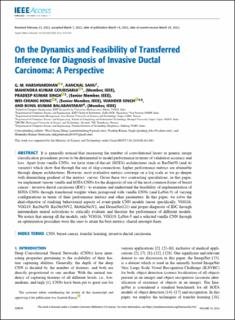| dc.contributor.author | Harshvardhan, G.M. | |
| dc.contributor.author | Sahu, Aanchal | |
| dc.contributor.author | Gourisaria, Mahendra Kumar | |
| dc.contributor.author | Singh, Pradeep Kumar | |
| dc.contributor.author | Hong, Wei-Chiang | |
| dc.contributor.author | Singh, Vijander | |
| dc.contributor.author | Balabantaray, Bunil Kumar | |
| dc.date.accessioned | 2023-01-31T15:33:28Z | |
| dc.date.available | 2023-01-31T15:33:28Z | |
| dc.date.created | 2022-05-04T15:02:56Z | |
| dc.date.issued | 2022 | |
| dc.identifier.citation | IEEE Access. 2022, 10 30870-30889. | en_US |
| dc.identifier.issn | 2169-3536 | |
| dc.identifier.uri | https://hdl.handle.net/11250/3047496 | |
| dc.description.abstract | It is generally noticed that increasing the number of convolutional layers in generic image classification procedures proves to be detrimental to model performance in terms of validation accuracy and loss. Apart from vanilla CNNs, we have state-of-the-art (SOTA) architectures such as ResNet50 (and its variants) which show that through the use of skip-connections, higher performance metrics are attainable through deeper architectures. However, most evaluative metrics converge on a log scale as we go deeper with diminishing gradient of the metrics’ curves. Given these two contrasting speculations, in this paper, we implement various vanilla and SOTA CNNs for the diagnosis of one of the most common forms of breast cancer - invasive ductal carcinoma (IDC) - to examine and understand the feasibility of implementation of SOTA CNNs through transferred weights when juxtaposed with vanilla CNNs (and LeNet-5) of varying configurations in terms of their performance metrics and other parameters. In this paper, we solve the dual-objective of studying behavioural aspects of avant-garde CNN models (more specifically, VGG16, VGG19, ResNet50, ResNet50V2, MobileNetV2, and DenseNet121) and proper diagnosis of IDC through intermediate neural activations to critically evaluate and theorize the performance of different models. We notice that among all the models, only VGG16, VGG19, LeNet-5 and a selected vanilla CNN through an optimization procedure were the ones to attain the best metrics, shared amongst them. | en_US |
| dc.language.iso | eng | en_US |
| dc.publisher | IEEE | en_US |
| dc.rights | Navngivelse 4.0 Internasjonal | * |
| dc.rights.uri | http://creativecommons.org/licenses/by/4.0/deed.no | * |
| dc.title | On the Dynamics and Feasibility of Transferred Inference for Diagnosis of Invasive Ductal Carcinoma: A Perspective | en_US |
| dc.title.alternative | On the Dynamics and Feasibility of Transferred Inference for Diagnosis of Invasive Ductal Carcinoma: A Perspective | en_US |
| dc.type | Peer reviewed | en_US |
| dc.type | Journal article | en_US |
| dc.description.version | publishedVersion | en_US |
| dc.source.pagenumber | 30870-30889 | en_US |
| dc.source.volume | 10 | en_US |
| dc.source.journal | IEEE Access | en_US |
| dc.identifier.doi | 10.1109/ACCESS.2022.3159700 | |
| dc.identifier.cristin | 2021507 | |
| cristin.ispublished | true | |
| cristin.fulltext | original | |
| cristin.qualitycode | 1 | |

